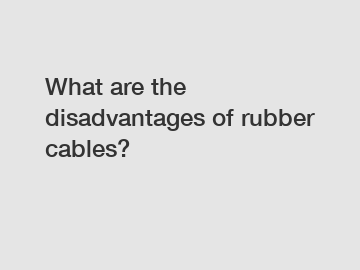Jan. 13, 2024
Electrical Equipment
What are the disadvantages of rubber cables?
Rubber cables have various disadvantages that make them less favorable in certain applications. One of the main drawbacks is their limited temperature range. Unlike other types of cables that can withstand high temperatures, rubber cables can only handle a relatively low temperature range. This restricts their use in environments where the temperature exceeds their capabilities, such as industrial settings with high heat production or intense chemical reactions.
Furthermore, rubber cables are susceptible to abrasion and wear. The soft and flexible nature of rubber makes it prone to damage when exposed to rough conditions or subjected to constant movement. This can lead to insulation damage, exposing the conductors and posing a safety hazard. The durability of rubber cables is further compromised when exposed to harsh chemicals, oils, and solvents, which can degrade the material over time.

Apart from their vulnerability to damage, rubber cables also have poor resistance to UV radiation. Prolonged exposure to sunlight or UV light sources can cause degradation of the rubber material, leading to cracks, brittleness, and loss of electrical insulation properties. This limits their outdoor usage, especially in applications where reliability is crucial, such as solar power installations or outdoor electrical equipment.
The disadvantages mentioned above are derived from the characteristics of rubber as a material. While rubber cables have their shortcomings, they are still widely used in various industries due to their flexibility, cost-effectiveness, and easy installation. However, it is important to carefully assess the application requirements and consider alternative cable types when necessary.
To mitigate the disadvantages of rubber cables, manufacturers have developed various strategies. One approach is to incorporate additives during the manufacturing process to improve the cable's resistance to heat, chemicals, and UV radiation. These additives modify the physical and chemical properties of the rubber, making it more suitable for specific applications. Additionally, protective coatings or sheathings can be applied to enhance the cable's durability and resistance to abrasion.
The disadvantages of rubber cables have implications for both safety and functionality. Insulation breakdown or failure can lead to electrical hazards, including short circuits and electrical fires. The limited temperature range can result in operational inefficiencies, reduced lifespan, and increased maintenance costs. Understanding these disadvantages is crucial for selecting the appropriate cable type, ensuring safe and reliable electrical installations.
In conclusion, the disadvantages of rubber cables stem from their limited temperature range, vulnerability to wear and abrasion, susceptibility to UV radiation, and limited resistance to chemicals. These drawbacks, however, should not overshadow the benefits of rubber cables, such as their flexibility and cost-effectiveness. By considering the application requirements and implementing appropriate measures, the disadvantages can be mitigated, ensuring safe and reliable electrical systems.
If you are looking for more details, kindly visit cable manufacturers in china, xlpe cable south africa, types of flexible armored cable.
Previous: Where are limit switches located?
Next: Which is Better: SC LC Fiber Patch Cord for High-Speed Data Transmission?
If you are interested in sending in a Guest Blogger Submission,welcome to write for us!
All Comments ( 0 )